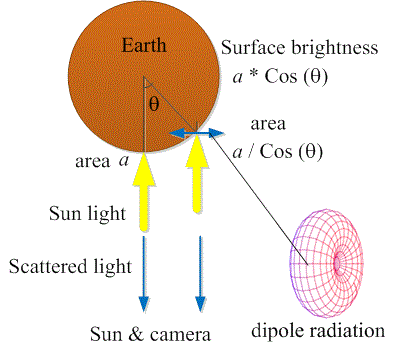Magic-Ball
Scattering of Directional Light
Particles in a box
The Sun and the Moon a Riddle in the Sky
Blue
Marble the Uniform Earth Image
Blue Marble the Uniform Earth Image
Uri Lachish, Rehovoth
![]()
Abstract
"Blue Marble", the full earth image, is uniform as well as all
the other full planet images and their moons. The uniformity is due to a single
event scattering of sunlight. Single event scattered light is coherent and leads
to enhanced backscattering of light, the opposition effect. Coherent backscattered
light is separable from non-coherent light by interferometry. It increases the
observation distance of celestial bodies, asteroids, and the penetration of image observation
within scattering media.
Introduction
The term "blue marble" was coined by NASA to the full earth
image taken by the Apollo 17 team in 1972 1. The first similar full earth image was
taken earlier in the DODGE (Department of Defense Gravity Experiment) in 1967 2. Images
are now available routinely since 2015 from the Deep Space Climate Observatory located
about 1.6*106 km from the earth 3.

Figure-1: The Blue Marble, full earth image taken by the Apollo-17 team 1.
According to Lambert's cosine law 4, the intensity of such images should be maximal at the image center, and fade to zero at the periphery by the cosine function. However, all these images have a common feature, starting from the first DODGE image to the present day images: The average image density is uniform from the face center of the image towards its periphery. More than that: The earth image includes large areas of gas phase – clouds, liquid phase – oceans, and solid phase – land, and the uniformity is nearly true for each phase separately. This feature is not discussed in the literature, not even mentioned in it.
The uniformity is not unique to the earth, but it is also observed in all the other planets and planet moons when they are back illuminated by the sun, that is, the image is 180 degrees backward scattered from the object toward the observer 5.
Light reflection from a material is considered in the literature either specular, mirror like, or diffusive. Specular reflection obeys the mirror law, while diffusive light scattering spreads in all direction. Random diffusive scattering is considered a multiple scattering event 6 and it must obey Lambert's scattering law 4: The scattering intensity is maximal in a perpendicular direction to the surface of the scattering body. It falls off according to the cosine function when the scattering angle deviates from perpendicular.
In the case of a sphere, backward scattering, scattering 180 degrees back, is maximal at the center of the sphere. It falls to zero according to the cosine function when advancing from the sphere surface center toward to its periphery. Bodies that their images comply with Lambert's cosine law are considered Lambertian scatterers 7, 8.
The uniform back scattered images, of all the planets and their moons 5, show that they are not Lambertian. There are thousands upon thousands of such images but not a single true photo that complies with the cosine law. The only images that do comply with the law are rendered, images that are at least partly simulated.
The earth's moon, our own moon, is the only body where the full image was studied in detail and theories have been suggested for the image uniformity. There are reviews of the subject including detailed reference lists 9-10. The hither to theories of light scattering from the moon face involve specific properties of the surface material, rocks and dust. They are not applicable to the earth image where the uniformity is observed separately in the air, sea, and land. It is more likely that a single theory should be applicable to the moon, earth, and all other cases.
Discussion
Going a little into the scattering mechanism may shed light on the observed earth images.
Light that travels within a material polarizes its matter. The electromagnetic radiation stimulates electric dipole oscillations within it, and each dipole becomes a source of electromagnetic radiation. Each dipole oscillates with a phase that is determined by its position in space, and its radiation field adds by vector addition to the stimulating radiation and the fields of the other dipoles. For uniform material the phases of the stimulated dipoles cancel each other in all the directions and sum up to zero except in the forward direction. Therefore, there is no scattered light in any direction except the forward direction, where the observed effect is refraction.
For a material with non-uniform density, each phase is summed with a different weight and the sum is not zero, so that scattered light may advance in any direction. Light is scattered from scattering centers and the scattered light intensity is equal to the sum of the light intensities of the centers.
A scattering center is a uniform sub-volume of a non-uniform volume. The scattering properties depend on the size of the center volume. For volume size smaller than the stimulating wavelength there will be scattering in all directions, Rayleigh scattering, and for volume size bigger than the wavelength, the scattering will be of small angle, Mie scattering.
Figure-2 shows an observing camera on a satellite looking at a full earth, while the sun is behind its back.

Sunlight brightness a * Cos(θ) on the earth illuminates the area a / Cos(θ) through a. The sun light polarizes the earth surface perpendicular to the light direction. The earth dipoles scatter maximum light back to the sun, and back to an observing camera on a satellite.
Each dipole oscillates in the electric field direction of the coming sunlight, that is, in a plane perpendicular to the light direction, and the maximal emission of a dipole is perpendicular to its direction of oscillation, that is, back to the sun and back to the observing camera.
Therefore, in single event scattering the mean equivalent light scattered 180 degrees back from the earth will also be directed back to the sun and to the camera. It will not be perpendicular to the earth surface.
Considering the fading sunlight on the earth surface, the back scattered light from the earth will be proportional then to: (a / Cos(θ)) * Cos(θ), The observing camera will see a uniform full earth.
Conclusions
In summary, the mean back scattering from the full earth is directed back to the sun because the scattering dipoles on the earth oscillate in a plane perpendicular to the coming sunlight. Any calculation that does not take the direction of the polarizing dipoles into account will not be correct.
The uniform full images of the planets and their moons tell us that the dominant scattering mechanism is single event scattering. Multiple scattering may add some correction.
All the scattering dipoles, in single event scattering, are stimulated by a common radiation source. Therefore, the back scattering from them must be coherent and there will be enhancement of the 180 degrees backscattered light 11. The enhancement is indeed attributed to coherent scattering in the literature 12-14, but since a single event scattering is not considered there, it is not clear why the scattered light will be coherent.
Coherent scattered light may be separated from non-coherent scattered light by interferometric methods, therefore the range of observing celestial bodies, asteroids and others, may be increased by applying interferometry.
The uniform images of the planets and their moons 5 also tell us that most of the scenery that surrounds us is that of singly scattered light. Applying backward scattering and interferometry enhances the depth of image observation within scattering media 15.
Multiple event scattering must lead to Lambert's cosine scattering law. However such images are rare, if observed at all. In the calculation of the law there is a hidden assumption that the scattering dipoles oscillate independently in all random directions in space. The images of the full earth, the planets and their moons tell us that this is not the case, the scattering mechanism must be mainly single events
In multiple scattering the dipoles lose their common plane of oscillation, therefore there is no way that the scattered light will be coherent. In addition, as a multiple event involves more and more scattering steps, the probability for it will diminish, and the first single scattering will be dominant.
References
- "Visible Earth: The Blue Marble from Apollo 17", https://visibleearth.nasa.gov/images/55418/the-blue-marble-from-apollo-17, December 2012.
- "The first color image of the entire Earth, taken by the DODGE satellite ", https://www.daviddarling.info/encyclopedia/D/DODGE.html, December 2012.
- "Daily natural color imagery of Earth from the EPIC camera onboard the DSCOVR spacecraft ", https://epic.gsfc.nasa.gov/.
- "Ikeuchi, Katsushi, "Lambertian Reflectance". Encyclopedia of Computer Vision. Springer. pp. 441–443 (2014)", 10.1007/978-0-387-31439-6_534. ISBN 978-0-387-30771-8.
- "True-Color Photos of All the Planets", https://owlcation.com/stem/True-Color-Photos-of-All-the-Planets.
- "A practical model for subsurface light transport", H.W.Jensen et al. (2001), A practical model for subsurface light transport.
- "W. J. Smith, Modern Optical engineering, 3rd Ed., (McGrow-Hill, NY, 2000), pp. 221-222.",
- "F. L. Pedrotti, L. S. Pedrotti, Introduction to Optics, 2nd Ed. (Prentic-Hall, NJ, 1993)."
- "Z.K. Kopal, An Introduction to the Study of the Moon, (Springer, 1966), p. 330", http://pdf.to/bookinfo/an-introduction-to-the-study-of-the-moon.pdf/.
- "Michael K. Shepard, Introduction to Planetary Photometry, Contemporary Physics, 59(1):1-1, Cambridge (2017)."
- "Uri Lachish, Full-Moon and Opposition", https://urila.tripod.com/opposition.pdf.
- "B. Hapke, et. al., The Opposition Effect of the Moon: Coherent Backscatter and Shadow Hiding", https://doi.org/10.1006/icar.1998.5907.
- "Bruce Hapke, The opposition effect, Cambridge University Press, pp 221-262 (2012)"
- "Akkermans, E.; P. E. Wolf; R. Maynard. "Coherent Backscattering of Light by Disordered Media: Analysis of the Peak Line Shape". Physical Review Letters. 56 (14): 1471–1474 (1986)"
- "Uri Lachish, Enhancing Tissue Depth Imaging", https://urila.tripod.com/tissue.pdf.
DOI: 10.13140/RG.2.2.10890.08640
by the author
- "The Sun and the Moon a Riddle in the Sky", https://urila.tripod.com/fullMoon.htm.
- "Full-Moon and Opposition", https://urila.tripod.com/opposition.pdf.
- "Poster", https://urila.tripod.com/poster.pdf.
- "Enhancing Tissue Depth Imaging", https://urila.tripod.com/tissue.pdf.
- "Blue Marbel the uniform Earth Image", https://www.researchgate.net/publication/346655971_Blue_Marble_the_Uniform_Earth_Image.
On the web: August 2020.